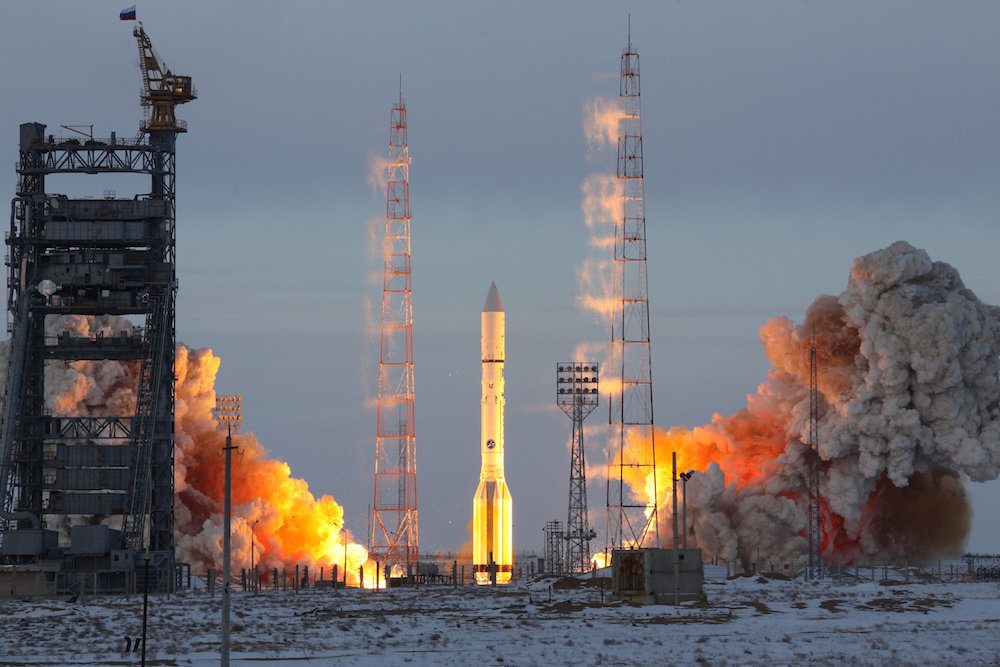The Secret Backstory Behind Kazakhstan's Rocket Launch Site

On June 6, if all goes according to plan, three people will rocket into space from a cosmodrome in Kazakhstan that has a fascinating history.
The Expedition 56/57 crew includes European Space Agency astronaut Alexander Gerst, NASA astronaut Serena Auñón-Chancellor and Russian cosmonaut Sergey Prokopyev.
But Kazakhstan isn't known for its space program. So why does the country have a large space facility known as the Baikonur Cosmodrome? And why are American and European space explorers launching from that site? [Interstellar Space Travel: 7 Futuristic Spacecraft to Explore the Cosmos]
It turns out, there's an intriguing backstory.
For most of its existence, the Kazakh cosmodrome was a secret site whose location was unknown in the West. It was built at the height of the Cold War in the 1950s, when Russia was part of the Soviet Union and the Space Age was just starting. The Soviets built a secret space facility that they called Baikonur, to make the West think the site was near a small mining town that shared that name. In reality, however, Baikonur was built near another town, called Tyuratam in what was then the ; the Soviets wanted to mask its true location for security reasons, according to Space.com, a Live Science sister site.
In fact, the first person in space, cosmonaut Yuri Gagarin, launched from the Baikonur Cosmodrome on April 12, 1961. For decades, the Soviets launched all their crews, space stations and even a Russian space shuttle (called Buran) from Baikonur.
Post-Soviet era
But with the fall of the Soviet Union in 1991, everything changed.
Get the Space.com Newsletter
Breaking space news, the latest updates on rocket launches, skywatching events and more!
Kazakhstan was an independent country. It wasn't clear if and when the Russians could launch their cosmonauts again (They had one other launch pad to the north, but it couldn't be used for most of their missions because of the orbital dynamics from that location.) Worse, Russian cosmonaut Sergei Krikalev was still stuck on the Mir space station; he remained in space for several extra months while the two countries negotiated over the future of Baikonur.
Ultimately, the solution was a lease agreement. Today, the Russians lease the Baikonur Cosmodrome from Kazakhstan for roughly $7 billion Russian rubles ($115 million) a year. Baikonur is a special enclave of Russian territory within Kazakhstan, meaning that foreign visitors are permitted with a Russian visa, Space.com reported.
By 1991, Baikonur's true location was known to the world. And Americans feared what could happen to that area of the world if Russia's nascent economy collapsed, the New York Times reported. To support Russia while benefiting from its space station, NASA agreed to a shuttle-Mir program, which paid Russia to host American astronauts on the Mir space station, Space.com reported.
The first American to fly into space on a Russian spacecraft, a Soyuz rocket, was Norman Thagard, in 1995. (The Soyuz is manufactured in Russia but launches from Kazakhstan after being brought there by rail.)
This partnership helped Russia and the United States practice training and launching astronauts together ahead of the launch of the International Space Station, which had its first construction flight in 1998. The number of Americans riding Soyuz rockets greatly increased beginning in 2011, with the retirement of NASA's space shuttle program, and NASA still relies on Russian rockets to get its crews to the International Space Station and will do so until the agency's next-generation commercial crew vehicles are ready.(Now, most space crews leave from Baikonur, with the exception of the Chinese, who have their own separate launch facilities.)
But that will change in the coming years. The SpaceX commercial crew program will likely see its first test flights in 2018 or 2019, allowing American astronauts to once again launch from U.S. soil. And Baikonur may also fade from Russian importance after the lease expires in 2050, according to Space.com. Another cosmodrome, called Vostochny, is already under construction in Russia, and the country eventually aims to launch crewed missions from that site, although the exact timing hasn't been disclosed.
Originally published on Live Science.
Join our Space Forums to keep talking space on the latest missions, night sky and more! And if you have a news tip, correction or comment, let us know at: community@space.com.

Elizabeth Howell (she/her), Ph.D., was a staff writer in the spaceflight channel between 2022 and 2024 specializing in Canadian space news. She was contributing writer for Space.com for 10 years from 2012 to 2024. Elizabeth's reporting includes multiple exclusives with the White House, leading world coverage about a lost-and-found space tomato on the International Space Station, witnessing five human spaceflight launches on two continents, flying parabolic, working inside a spacesuit, and participating in a simulated Mars mission. Her latest book, "Why Am I Taller?" (ECW Press, 2022) is co-written with astronaut Dave Williams.










